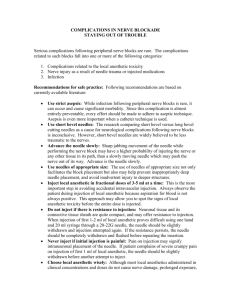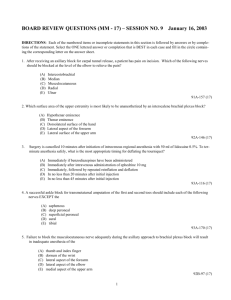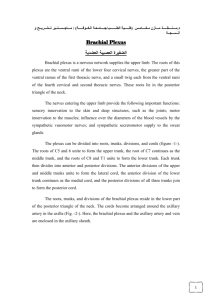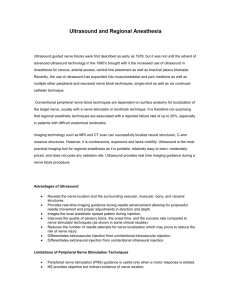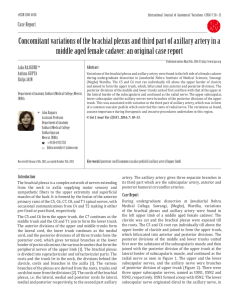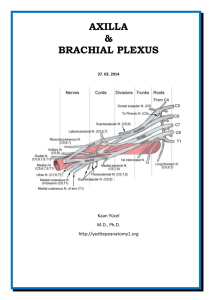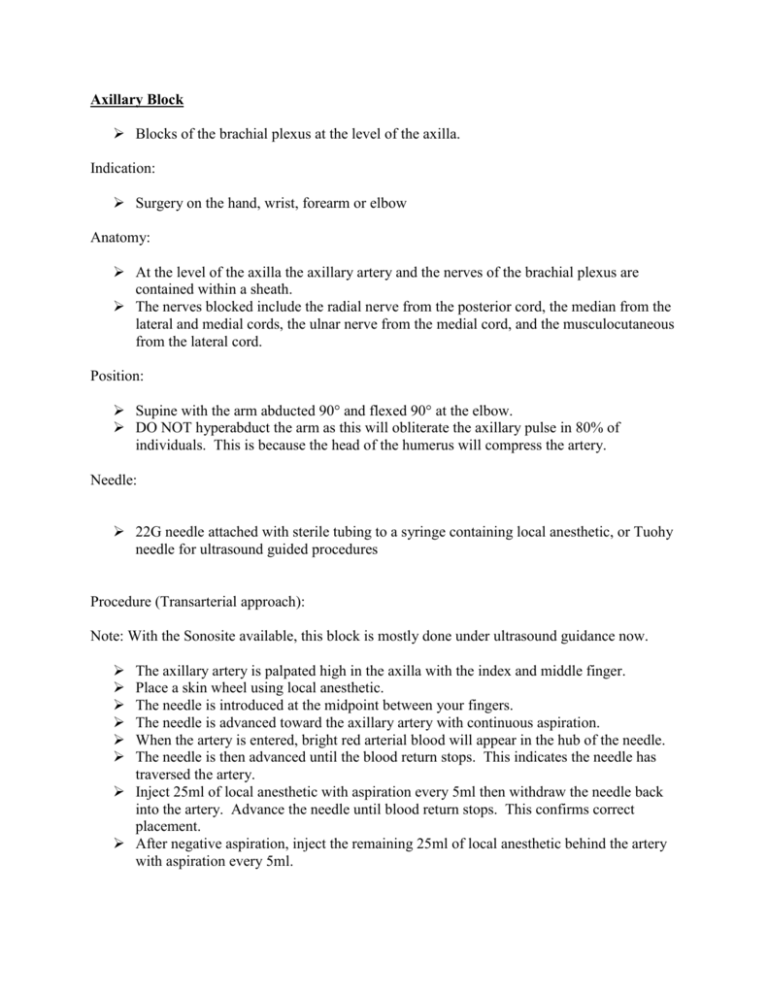
Axillary Block
Blocks of the brachial plexus at the level of the axilla.
Indication:
Surgery on the hand, wrist, forearm or elbow
Anatomy:
At the level of the axilla the axillary artery and the nerves of the brachial plexus are
contained within a sheath.
The nerves blocked include the radial nerve from the posterior cord, the median from the
lateral and medial cords, the ulnar nerve from the medial cord, and the musculocutaneous
from the lateral cord.
Position:
Supine with the arm abducted 90° and flexed 90° at the elbow.
DO NOT hyperabduct the arm as this will obliterate the axillary pulse in 80% of
individuals. This is because the head of the humerus will compress the artery.
Needle:
22G needle attached with sterile tubing to a syringe containing local anesthetic, or Tuohy
needle for ultrasound guided procedures
Procedure (Transarterial approach):
Note: With the Sonosite available, this block is mostly done under ultrasound guidance now.
The axillary artery is palpated high in the axilla with the index and middle finger.
Place a skin wheel using local anesthetic.
The needle is introduced at the midpoint between your fingers.
The needle is advanced toward the axillary artery with continuous aspiration.
When the artery is entered, bright red arterial blood will appear in the hub of the needle.
The needle is then advanced until the blood return stops. This indicates the needle has
traversed the artery.
Inject 25ml of local anesthetic with aspiration every 5ml then withdraw the needle back
into the artery. Advance the needle until blood return stops. This confirms correct
placement.
After negative aspiration, inject the remaining 25ml of local anesthetic behind the artery
with aspiration every 5ml.
Comments:
The musculocutaneous nerve is often spared with the axillary block. The
musculocutaneous nerve can be blocked by a separate injection.
If the patient reports paresthesias in the hand it signifies the needle is within the axillary
sheath.
If the artery cannot be palpated a Doppler can be used to locate the artery.
After the artery has been located with the Doppler the needle is advanced parallel to the
probe until the artery is entered.
Axillary Block Using the Nerve Stimulator
Blocks of the brachial plexus at the level of the axilla.
Indication:
Surgery on the hand, wrist, forearm or elbow
Anatomy:
Copyright 2004, Icon Learning Systems, LLC. A subsidiary of MediMedia, USA, Inc. All rights reserved.
At the level of the axilla the brachial plexus is enveloped by a sheath which contains the
axillary artery, the axillary vein and the nerves of the brachial plexus.
The median nerve lies superior to the axillary artery.
The ulnar nerve inferior to the axillary artery.
The radial nerve lies behind the axillary artery.
The relation of the nerves is however variable.
Position:
Supine with the arm abducted 90° and flexed 90° at the elbow.
DO NOT hyperabduct the arm as this will obliterate the axillary pulse in 80% of
individuals. This is because the head of the humerus will compress the artery.
Needle:
24G 50mm Stimuplex needle
Procedure:
Place a skin wheel high in the axilla.
The Stimuplex needle is introduced through the skin wheel.
The needle is advanced with continuous aspiration until proper stimulation is obtained.
Median Nerve: Wrist flexion, 2nd and 3rd finger flexion
Obtain and appropriate motor response at <0.4mA
Inject 10-15ml of local anesthetic
Ulnar Nerve: Thumb adduction, 4th and 5th finger flexion
Obtain and appropriate motor response at <0.4mA
Inject 10-15ml of local anesthetic
Radial Nerve: The Arm/Finger/Wrist extension, supination.
Obtain and appropriate motor response at <0.4mA
Inject 10-15ml of local anesthetic
Comments:
Radial nerve stimulation is associated with the highest success rate.
If the patient reports paresthesias in the hand it signifies the needle is within the axillary
sheath.
A high volume of local anesthetic (40-50ml) promotes proximal spread past the coracoid
process and insures blocking all components of the brachial plexus.
Musculocutaneous Nerve Blocks
Anatomy
Copyright 2004, Icon Learning Systems, LLC. A subsidiary of MediMedia, USA, Inc. All rights reserved.
The musculocutaneous nerve supplies the flexors of the elbow and provides sensation to
the lateral aspect of the forearm (lateral antebrachial cutaneous nerve).
Immediately after its origin, the musculocutaneous nerve enters the coracobrachialis
muscle.
Procedure
a. Blind Method
To block the nerve a 22G 1.5” short bevel needle is inserted into the substance of the
coracobrachialis muscle under the biceps tendon.
It is not necessary to obtain a paresthesia since the muscle is small and the local
anesthetic injected will be confined within its fascia.
b. Nerve Stimulation Method
Same as above, use a 22G 50mm insulated needle and obtain flexion of the elbow at <
0.5mA.
Inject 5 – 8ml of local anesthetic.


